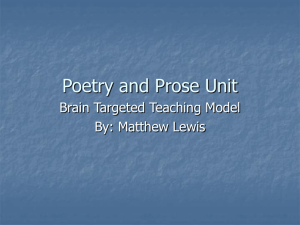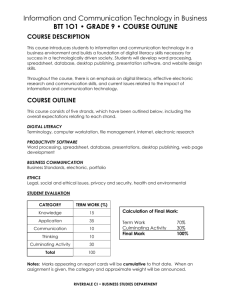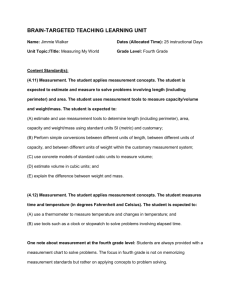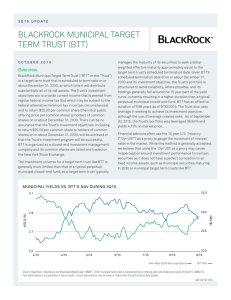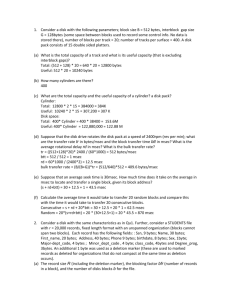The Rates and Revenue of Bank Transaction Taxes
advertisement
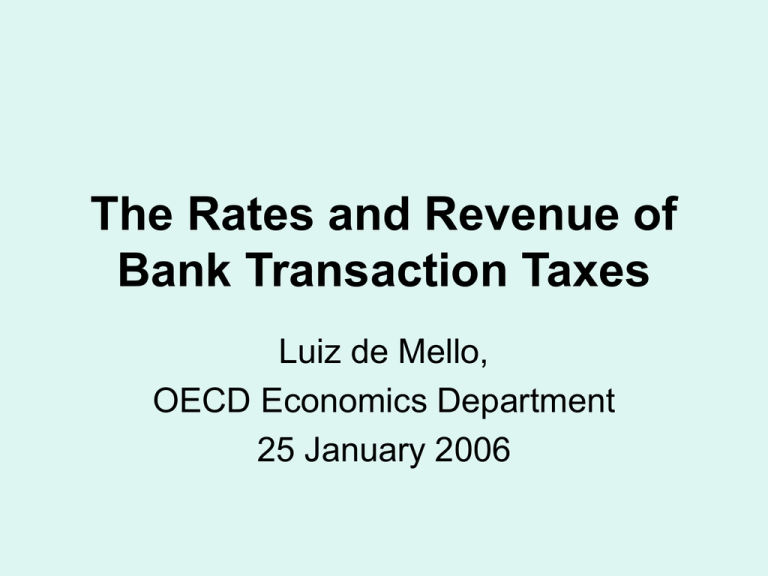
The Rates and Revenue of Bank Transaction Taxes Luiz de Mello, OECD Economics Department 25 January 2006 Motivation • BTTs are not exactly new – In 1898, the U.S. government introduced a two cent tax on bank checks to finance the Spanish-American war • BTTs are prevalent in Latin America – Since 1976, BTTs have been introduced repeatedly in Argentina, Brazil, Colombia, Ecuador, Peru and Venezuela – As of end-2004, such taxes were in effect in six Latin American countries: Argentina, Brazil, Bolivia, Colombia, Peru and Venezuela Are BTTs a reliable source of revenue? The priors • The theoretical arguments are inconclusive; thus, it is an empirical question – If BTTs do not provide a reliable source of revenue (ie, their revenue yield declines while distortions increase), they should be used only in extraordinary situations and over a short period of time • Even if BTTs are a reliable source of revenue, their enactment may not be desirable due to transaction costs and deadweight losses – Stable revenue productivity is a necessary, but not sufficient, criterion for the desirability of BTTs The findings • A 0.1 percentage point increase in the statutory rate reduces the revenue base (or productivity) by 0.180.30%. => increasing the tax rate erodes the tax base by more than it raises revenue. • Increasing the BTT rate accelerates the speed at which the tax base is eroded. – For example, for the tax rate of 0.2%, the second-year revenue is 9% lower than during the first year the tax is in effect, while for a tax rate of 0.3%, revenue is nearly 30% lower in the second year compared to the first year • BTTs yield more revenue in countries with deeper financial systems or higher inflation and deposit-lending interest spreads The literature (general) • Coelho, Ebrill and Summers (2001): BTTs have been successful in raising revenue in the short term, but there is evidence that these taxes have resulted in financial disintermediation • Kirilenko and Perry (2004): estimate the degree of disintermediation (a permanent erosion of the tax base) resulting from the introduction of a BTT in Argentina, Brazil, Colombia, Ecuador, Peru and Venezuela – On average, the introduction of a BTT results in disintermediation of between 4 and 44 cents for every dollar in revenue (loss of over 0.5% of GDP) – Disintermediation effects are stronger as the taxes remain in place The literature (case studies) • Albuquerque (2003): BTT increases the cost of government borrowing in Brazil and advocates against the use of this tax • Arbeláez, Burman and Zuluaga (2002): panel data analysis to estimate the effect of a BTT on interest margins and profitability of 43 financial institutions in Colombia during 1995-2001. – BTT increased the cost of credit and led to significant disintermediation – The authors recommend abolishing the tax. The literature (cont’d) • Lastrapes and Selgin (1997): impact of a two-cent check tax on the U.S. economy during the 1930s – They estimate the impact of the tax on the currency-deposit ratio and the money and show that the BTT led to significant disintermediation • Honohan (2003): analytical overview of the four main types of tax bases for the financial sector: income, expenditures, assets and transactions • Literature on corrective financial transaction taxes. The Latin American case • As of end-2004, BTTs were in effect in six Latin American countries: Argentina, Brazil, Bolivia, Colombia, Peru and Venezuela. Ecuador levied such taxes in the past • Tax rates have ranged between 0.2-2.0%, varying widely both across countries and over time • The list of taxable financial transactions also differs across countries. – In most cases, only debit transactions are taxed (ie, check clearance, withdrawals from ATMs, loan repayments) – But in Argentina 2001-04 and Ecuador 1999-2000 credits were also taxed. In Colombia only credit transactions were taxed during 1999-2004. The Latin American case (cont’d) • In most countries, certain institutions (e.g., government agencies and charitable organizations) and specific transactions (e.g., transactions with the central bank and among different government agencies) are exempted from taxation – In Argentina (through 1992 and April-December 2001) and Ecuador, a portion of the BTT liability was creditable against the income or value added taxes The revenue performance of BTTs has been quite diverse • Revenue performance has been particularly strong in Brazil and Colombia – Annual revenue in the range of 0.6-1.6% of GDP for effective tax rates in the range of 0.2-0.38% • BTT productivity has been on a declining trend – There appears to be a strong negative nonlinear relationship between revenue productivity and the tax rate => This is the basic relationship that we investigate in greater detail in the remainder of the paper. BTT rate and productivity Productivity 6 5 4 3 y = 1.3036x-0.6153 Br-94 R2 = 0.5026 Br-98 Br-97 Br-00 Br-02 Br-01 Br-04 Br-03 Br-99 Co-99 Co-00 Co-01 Co-02 Co-03 Co-04 Ve-99 2 Pe-04 1 0 0.00 Ve-00 Ve-04 Ar-92 Ar-90 0.25 0.50 Ve-02 Ve-94 Ve-03 Ar-01 Ar-04 Ar-02 Ar-03 Ar-88 Ar-89 Ar-91 Pe-91 0.75 1.00 1.25 Ec-00 Ec-99 Pe-90 1.50 1.75 2.00 2.25 Tax Rate Estimating strategy • Equation consistent with a nonlinear relationship between BTT productivity and its effective rate; several functional forms (ie, quadratic, logistic and linear) • Use instrumental variable estimation (2SLS) and GMM. – The effective BTT rate is likely to be endogenous – The error terms are likely to be heteroscedastic and serially correlated – The main explanatory variables are likely to be jointly correlated and measured with error Data • Monthly data for the statutory rates and revenues for six Latin American countries: Argentina, Brazil, Colombia, Ecuador, Peru and Venezuela – Last observation for the countries where BTTs remain in effect is December 2004. – Monthly data were aggregated into quarterly observations and used quarterly GDP to compute productivity. In addition, the pre-1993 period was excluded from the panel for Argentina because of the lack of reliable quarterly GDP data. • We calculate effective tax rates for each quarter as a weighted average of the effective monthly rates during each month within the quarter • To compute the effective monthly rates, we use the actual dates of introduction of the tax, which often took place during, rather than at the beginning of, the month. Whenever the tax is levied on both debits and credits, we multiply the statutory tax rate by two • Unbalanced panel of at most 114 quarterly observations for BTT productivity The baseline findings • Regression results are reported using the pooled OLS, FE, 2SLS and GMM estimators for a linear specification, as well as the GMM estimator for the logistic and quadratic specifications – In all cases, we find a statistically significant negative relationship between effective rates and productivity of taxes on bank transactions • For the linear models, the pooled, 2SLS and GMM regressions suggest that a 0.1 percentage point increase in the effective rate reduces productivity by about 0.18-0.30 percentage points – Based on the mean effective rate (0.6%) and productivity (2.4%) in the sample, if the effective rate were to be increased by a third (from 0.6% to 0.8%), productivity would fall by about one-fifth (from 2.4% to 1.9%) – The elasticity is much lower in magnitude with FE • An increase in the mean effective rate by one-third would reduce mean productivity by about 10% in the case of a logistic specification The determinants of BTT productivity Pooled OLS Intercept RATE 3.47 ** (16.709) -2.27 ** (-7.216) Linear models Fixed effects 2SLS 1/ -0.46 ** (-2.592) 3.98 ** (17.615) -3.03 ** (-7.8756) GMM 1/ 4.00 ** (14.910) -3.06 ** (-7.114) Non-linear models 2/ Logistic Quadratic 5.37 ** (7.294) -1.76 ** (-4.5316) RATESQ Nobs. R-squared FE test (p -value) Overid. test (p-value) 114 0.29 ... ... 114 0.85 [0.000] … 72 0.42 … 0.77 91 0.41 … 0.67 91 0.46 … 0.85 4.79 ** (12.224) -6.00 ** (-6.146) 2.04 ** (4.443) 91 0.45 … 0.81 The full models • Because of the likely reverse causality and joint endogeneity of the regressors, we use the GMM estimator and a logistic functional form to account for possible nonlinearity in the estimated relationship • Proxies for financial deepening: – – – – Ratio of money to quasi-money (MONQMON), Ratio of claims on government to private sector credit (CLAIM) Interest rate spread (SPREAD) Ratio of currency outside banks to banks’ liquid liabilities (COBLIAB) • Proxies for the opportunity cost of disintermediation: – Inflation (CPI) and a share price index (SHARE) Results • Strong negative relationship between the BTT rate and productivity is confirmed • The role of financial deepening? – The ratio of money to quasi-money is negatively signed and statistically significant => BTTs are more productive in countries with deeper financial markets • Controls? – Inflation is positively correlated with productivity, but the coefficient on the stock market index is not robust across model specifications – Interest rate spread is positively correlated with productivity – The ratio of claims on government to private sector credit is negatively correlated with productivity More on the determinants of BTT productivity Baseline Full model 1 Intercept RATE 5.37 ** (7.294) -1.76 ** (-4.5316) 2.32 ** (9.801) -1.94 ** (-4.303) 4.57 ** (9.985) -2.26 ** (-7.241) 2 3.15 ** (6.813) -2.66 ** (-7.357) Robustness 3 2.87 ** (10.853) TREND 4 5 1.88 ** (7.819) -1.49 ** (-3.249) 0.02 ** (3.028) TRENDSQ MONQMON -0.01 * (-2.319) COBLIAB CPI 0.01 (7.926) 0.01 (3.489) -0.01 (-2.097) 0.00 (-1.688) SPREAD CLAIM SHARE Nobs. R-squared Overid. Test (p-value) 91 0.46 0.85 68 0.76 0.55 ** ** * + -0.06 ** (-6.867) 0.01 ** (7.574) 0.00 ** (3.166) 0.00 (0.124) 0.00 (-0.772) 75 0.81 0.71 0.01 ** (2.881) 0.00 (0.626) 80 0.68 0.15 -0.02 ** (-6.810) 0.00 (0.174) 0.01 ** (5.947) 0.01 ** (2.692) -0.02 ** (-7.290) 0.00 (-1.556) 0.00 (2.467) 0.01 (4.980) -0.01 (-3.185) 0.00 (-3.368) 68 0.73 0.18 68 0.78 0.32 * ** ** ** 1.65 (4.943) -1.62 (-3.931) 0.04 (2.376) -0.01 (-1.673) -0.02 (-0.446) ** 0.01 (2.540) 0.01 (3.573) -0.01 (-3.506) -0.01 (-2.386) * 68 0.76 0.31 ** * + ** ** * Robustness? • The results are robust to the use of the ratio of currency outside banks to banks’ liquid assets to proxy for financial deepening instead of the ratio of money to quasi-money • And to excluding the explanatory variables that are most strongly correlated with the effective rate (i.e., the ratio of money to quasimoney, the interest spread and the ratio of claim on government to private sector credit) – The coefficient of the effective rate is greater in absolute value relative to the full model • As well as excluding the effective rate, while keeping its lagged values in the set of instruments, and keeping all other explanatory variables – The estimated coefficients of the remaining explanatory variables are robust to this alternative model specification, although SHARE loses significance A final point: BTT productivity might be affected by the length of time the tax remains in place • Motivation comes from Laffer-type curves for the relationship between the BTT rate and productivity (or tax base) over time: – BTT productivity seems to decline over time, especially for higher rates – The Laffer curves shift toward the origin as the BTT remains in effect The revenue-maximizing rate decreases over time – Increasing the BTT rate accelerates the speed at which the tax base is depleted • For a tax rate of 0.2%, second-year revenue is 9% lower that during the first year the tax is in effect. • For a tax rate of 0.3%, BTT revenue is nearly 30% lower in the second year relative to the first year. – Thus, an estimate of the revenue-maximizing BTT rate that does not take into account the shrinking of the tax base would be biased upward => For example, in our quadratic model, a simple calculation of a revenuemaximizing rate yields an estimate of about 1.5%: a very high rate for a BTT. In contrast, as can be seen in Figure 2, the revenue-maximizing rate based on the data for the fourth and later quarters is about 0.4% A final point (cont’d) • TREND is positively signed and statistically significant. – It takes time for taxpayers to learn how to avoid paying the BTT and for the tax administration to learn how to enforce I”: it may take time for the enforcement effect to outweigh the tax avoidance effect – TREND squared: productivity does increase with time, but the tax avoidance effect tends to kick in after about 2 quarters following the introduction of the tax Laffer curves or fireworks? Revenue as percent of GDP 2.0 1.8 1.6 1.4 1.2 1.0 1st semester 2nd semester 3rd semester 4th semester Quadratic, 1st sem Quadratic, 2nd sem Quadratic, 3rd sem Quadratic, 4th sem 0.8 0.6 0.4 0.2 0.0 0.0 0.2 0.4 0.6 0.8 1.0 1.2 1.4 1.6 Tax rate To sum up • Bank transaction taxes are not a reliable source of revenue, especially over the medium term • Our results are robust: they hold for different functional specifications of the underlying relationship, alternative estimation techniques and the inclusion of various controls • Moreover, raising the tax rate causes the tax base to shrink by more than it raises revenue. • We therefore conclude that these taxes should be used only as a temporary means to mobilize revenue in situations of fiscal duress. • More research is needed to gauge the full impact of BTTs: – How the taxation of bank transactions affects capital markets and interest rates, in conjunction with other levies on financial institutions, transactions and income


